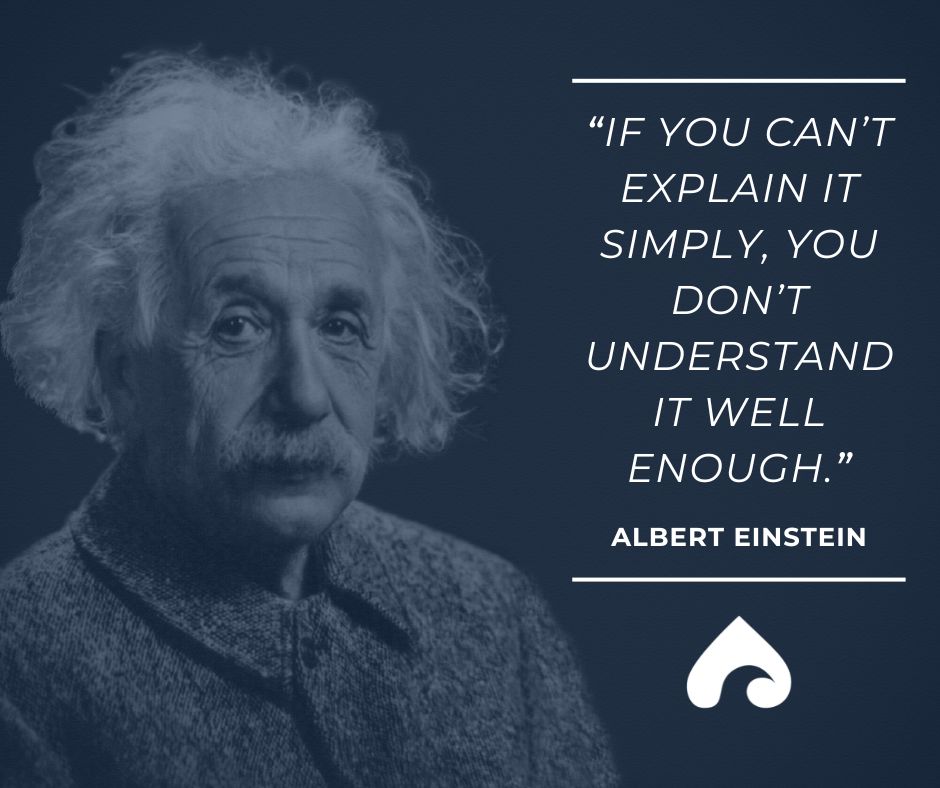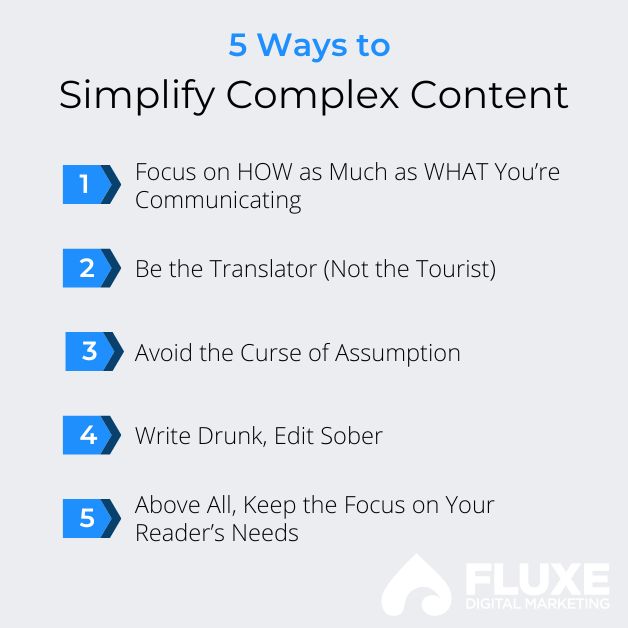You’re smart.
Before you let that go to your head, hear me out.
You’ve spent a great deal of time in your area of expertise, and you probably know it just as well as or better than anyone else out there. And that’s seriously incredible.
The problem isn’t that you’re too smart for your audience. The problem is that you have so much knowledge and expertise in your field that it can be difficult to recognize what it was like to be a beginner.
So what happens?
You want to appeal to as many readers as possible, so you try to make all the content so simple and easy to understand that it’s almost insulting.
As a result, you sacrifice credibility with the people who know what they’re talking about in your field, which can be detrimental not only to your reputation but also to your readership.

But there’s a better way, and it involves creating content that is simultaneously smart and accessible.
The goal is not to remove nuance or make things simpler than they really are so no one gets offended or confused. The goal is to communicate complex ideas more clearly so that even someone new to the field can follow along and understand what’s going on.
That said, there’s a big difference between simplifying your content and dumbing it down. Never sacrifice accuracy just because you’re afraid of losing readership by challenging them intellectually. The whole point of writing in a way that’s easy for anyone to understand is that we want everyone to be able to engage with our work — not just those who are already familiar with the topic.
Be mindful of this distinction, but don’t shy away from being educational and informative if you have something important to say.

5 Ways to Simplify Complex Content
Below are five ways you can simplify and clarify your message without talking down to your audience:
1: Focus on HOW as Much as WHAT You’re Communicating
I know I said keep your content simple, but you don’t really want to make your content simple — you want to make it better… right?
In other words, it’s not about dumbing down your content so that anyone can understand it. That’s just a waste of time and effort. Instead, think about simplifying the way you explain complex concepts so they’re easier for everyone to grasp.
This means getting rid of jargon and making sure every sentence is clear and concise (and doesn’t require an English degree to decipher! Think 5th grade reading level). It also means not assuming everyone has equal knowledge or experience on the topic at hand; some people will know what you’re talking about right away while others may need more explanation or context before they get there.
That may sound great, but what does it actually look like? Whenever you introduce a new idea in an article, be sure to reinforce it with a clear explanation and supporting points like examples, stats, stories, analogies, or metaphors.
2: Be the Translator (Not the Tourist)
As a Subject Matter Expert (SME), you are the translator of your expertise. You understand the background, context, and nuances of your niche and have the opportunity and responsibility to translate and communicate your knowledge into a format that resonates with your target audience.
Tourists use travel guides (or, nowadays, Google Translate) as translators. Bloggers don’t need any of those tools because we already possess invaluable knowledge of our own topics.
I was sitting next to a woman on a plane the other day on the way to an EO event. Turns out she was heading to the same event and owned a language translation business. One thing they excelled at was contextual translation, which is the difference between throwing a paragraph into Google Translate and taking the time to understand the context around that piece of info and translating it accordingly.
A tourist would blindly translate an article on gardening into another language without knowing anything about gardening; this results in “dumbing down” content because it strips away nuance, detail, and accuracy.
Are you simply relaying facts, or are you adding your own expertise and insight along the way to provide context from your experiences that enhances the reader’s level of understanding of the topic?
3: Avoid the Curse of Assumption
To avoid dumbing down your content, you must understand your target audience on a deeper level than your competitors. Don’t fall into the trap of assuming your reader is at the same level of understanding or experience as you.
A great way to figure out the stage of your audience is by using the 5 Stages of Awareness.
When it comes to writing for the web, we recommend using simple language. My dictionary says simple means:
- Easy to understand
- Uncomplicated
- Basic
- Plain
- Straightforward
- Elementary
- Undemanding in nature or degree
One useful, free tool you can use to check your writing level is Hemingwayapp.com which gives you a reading level based on Flesch-Kincaid scores and suggests ways to improve readability.

Finally, make sure you’re using appropriate formatting when writing for the web, including headings and lists so readers can easily scan through articles and find what they’re looking for quickly. If you want more info on formatting your blog posts to improve conversions, click here.
4: Write Drunk, Edit Sober
The “write drunk, edit sober” adage has been around for years and is often attributed to Hemingway. But while the author did indeed have a drinking problem, I’m not so sure he was advocating writing while intoxicated.
Rather than taking it literally — please don’t write drunk! — I think this quote should be interpreted as a metaphor for what happens when we let our guard down and allow ourselves to be spontaneous in a conversation or writing situation.
When you’re sober, there’s nothing wrong with being logical and structured about things. It’s important for writers (and anyone else who puts pen to paper) to exercise discretion when it comes to editing their work; but at the same time, we need that creative spark in order for our ideas (and overall content) to come alive. Otherwise we’d end up with a lot of boring content, right?
The trick is striking an appropriate balance between spontaneity and structure. Too much of one will make your writing gimmicky or cheesy; too much of another will make it dry and monotonous.
5: Above All, Keep the Focus on Your Reader’s Needs
Your reader is the hero of your content. You are the guide, helping them reach their destination — whether that’s buying from you, signing up for your email list, or performing any other action you want them to take.
The best way to write content that readers will love? Focus on them! Don’t get caught up in how important or awesome your business is — the focus should be on delivering value to the people reading.
The more you understand what your audience needs to hear and how they think about certain topics, the better you’ll be able to craft content that resonates with them on a deep level.
1. Grab a free copy of my book, “The Content Marketing Accelerator”
Learn our 6-step framework for converting your best ideas into world-class content in just one hour per month. Click Here
2. Join us on our Facebook page
Join other business owners on our Facebook page where we share juicy tips and tutorials we don’t share anywhere else! Click Here
3. See if we’re a good fit
If you’re interested in creating results-oriented content in less time, just reply with “content” in the subject line, tell me a little about your marketing goals, and I’ll get you the details!



